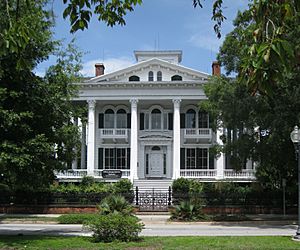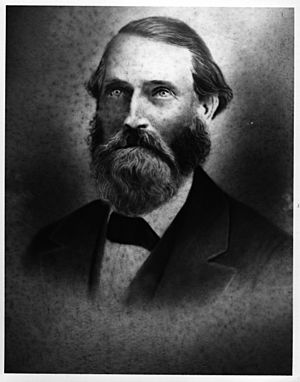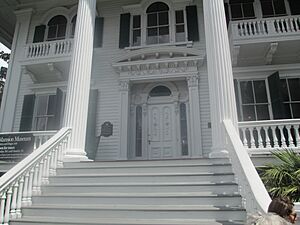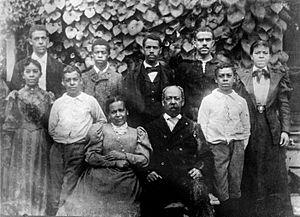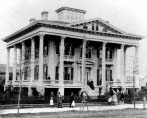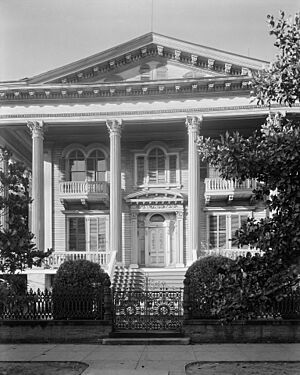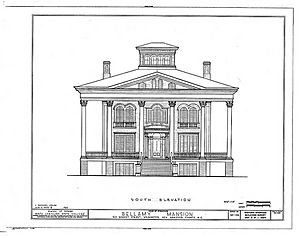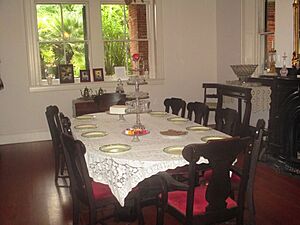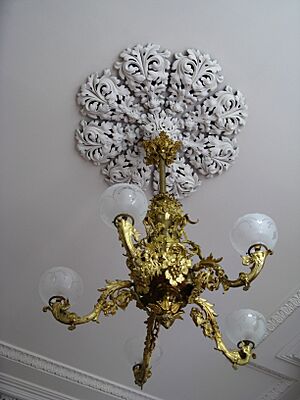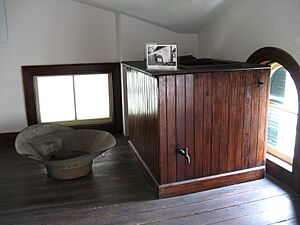Bellamy Mansion facts for kids
The Bellamy Mansion, built between 1859 and 1861, is a beautiful old house in downtown Wilmington, North Carolina. It mixes different styles like Greek Revival and Italianate. This mansion is one of the best examples of historic homes built before the American Civil War in North Carolina. It is also part of the Wilmington Historic District.
Contents
A Look Back in Time
In 1860, Wilmington was the biggest city in North Carolina. It was a very important port city, especially for the "naval stores industry," which made things like tar and pitch for ships. This made it a great place for people like Dr. John D. Bellamy to become successful.
The Bellamy Mansion has twenty-two rooms and was built using the skills of both enslaved carpenters and free Black artisans. The main architects were James F. Post and his assistant, Rufus W. Bunnell.
The mansion was first built for Dr. John D. Bellamy, who was a doctor and businessman. He and his wife, Eliza Bellamy, moved in during early 1861 with eight of their children. Eliza was also expecting their tenth child. Nine enslaved workers lived in separate buildings on the property.
Over the years, the mansion has seen many important events. Federal troops took it over during the Civil War. It survived a big fire in 1972. Two generations of the Bellamy family lived there. Now, after a lot of hard work to fix and preserve it, the Bellamy Mansion is a museum. It teaches visitors about history and design.
Today, the mansion is cared for by Preservation North Carolina. This is a private group that works to protect in North Carolina.
The Bellamy Family
Dr. John Dillard Bellamy (born 1817, died 1896) married Eliza McIlhenny Harriss (born 1821, died 1907) in 1839. They had ten children: Mary Elizabeth (Belle), Marsden, William James Harriss, Eliza (Liza), Ellen Douglass, John Dillard Jr., George Harriss, Kate Taylor, Chesley Calhoun, and Robert Rankin.
When he was young, Dr. Bellamy inherited land and enslaved workers in Horry County, South Carolina. He later moved to Wilmington to study medicine. After marrying Eliza, he took over her father's medical practice. The Bellamys lived in a few different homes in Wilmington before building their grand mansion on Market Street.
By 1860, when they were getting ready to move into their new home, the Bellamy family included eight children. Nine enslaved workers also lived on the property. Robert Rankin, their last child, was born in the mansion in 1861.
Dr. Bellamy became very wealthy. He was a successful doctor, but most of his money came from other businesses. He owned a turpentine factory and was involved with banks and railroads. He also owned large farms where he raised animals and grew crops. In 1860, he owned 114 enslaved workers across three counties in North Carolina. This made him one of the wealthiest people in the state.
Dr. Bellamy's sons also became successful. Marsden became a lawyer, and William became a doctor like his father. George became a farmer and later served in the North Carolina Senate. Robert became a successful businessman in the medicine industry. John Jr. became a lawyer and a United States Congressman. Sadly, Chesley Calhoun died young while studying at college.
Only one of Dr. and Mrs. Bellamy's daughters, Mary Elizabeth (Belle), married and had children. Her sisters Eliza and Ellen lived their lives unmarried in the family mansion. Ellen later wrote a book about the mansion's history.
In March 1861, the family moved into their new home and had a big party. However, the Civil War started the very next month, which stopped all their entertaining for four years.
North Carolina officially left the Union in May 1861. Dr. Bellamy supported this decision. His oldest son, Marsden, joined the Confederate Navy, and his younger son, William, joined the Wilmington Rifle Guards.
Workers at the Mansion
When the Bellamys moved into their big house, nine enslaved workers lived in the smaller buildings on the property. Guy Nixon was the butler and carriage driver. Tony Bellamy was the caretaker. Sarah Miller Sampson was a housekeeper and cook. Other enslaved women worked in the home, including Joan, a nanny, and her daughter Caroline, who was Mrs. Bellamy's "little maid."
Enslaved craftsmen, like brick masons, carpenters, and plasterers, were hired by Dr. Bellamy for the mansion's construction. This was called the "hiring out" system. These workers would gather at the Market House, and wealthy men would hire them for jobs, often in construction.
Even the people who built the Bellamy Mansion ended up on different sides during the Civil War. James F. Post, the architect, joined the Confederate artillery. Rufus W. Bunnell, his assistant, joined the Union Army.
William B. Gould, an enslaved plasterer, worked for Dr. Bellamy. He managed to escape from Wilmington in 1862 with other enslaved workers. They rowed a boat to a Union blockade ship, and Gould joined the Union Navy. Even though it was illegal to teach enslaved people to read and write in North Carolina, Gould kept a detailed diary during the war. This diary is one of the few written by a former enslaved person serving in the Civil War. After the war, Gould continued his plastering work in Massachusetts, where he married and had eight children. His great-grandson later published his diary as a book.
After the Civil War, Dr. Bellamy used paid workers. Only one of the enslaved workers who had lived at the mansion before the war, Mary Ann Nixon, stayed on as a paid servant.
Mansion's History Through the Years
During the Civil War, the Bellamy family stayed in their new home. However, a serious yellow fever outbreak forced them to leave Wilmington and go to their Grovely Plantation. In January 1865, they learned that Fort Fisher had fallen to Union troops. This was a huge loss for the Confederacy, as Wilmington was the last major port supplying the southern states.
When Union troops arrived in Wilmington in February 1865, they took over the nicer homes whose owners had left. The Bellamy Mansion was chosen to be a headquarters for military staff. General Joseph Roswell Hawley was put in charge of Wilmington and used the Bellamy House. His wife, Harriet Foote Hawley, a nurse, came to help the wounded.
After the war ended in April 1865, the Federal Government took control of southern properties, including Dr. Bellamy's land and home. Dr. Bellamy tried to get his house back, but General Hawley would not let him into Wilmington because of his strong support for the Confederacy.
Mrs. Bellamy went to Wilmington in May 1865 to meet with Mrs. Hawley, hoping to get their home back. It must have been difficult for Eliza Bellamy to be a guest in her own home, especially since she supported slavery and Mrs. Hawley came from a family that was against it. Mrs. Hawley was even a cousin of Harriet Beecher Stowe, who wrote the famous anti-slavery book Uncle Tom’s Cabin.
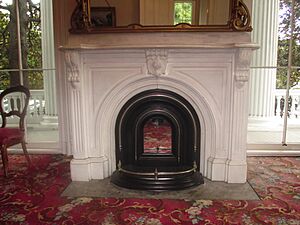
Dr. Bellamy's process to get his home back took a long time because of his political views and his past as a large slaveholder. In the summer of 1865, he asked for a pardon to reclaim his property. By August, he received a pardon from President Andrew Johnson for his plantation land and businesses, but the Bellamy House was still under military control. Eliza wrote that the house was very dirty, especially the basement. By the end of September 1865, the Bellamy family was finally able to return home.
Dr. Bellamy got his property back, but he now had to hire paid workers for his businesses and the family home. He went back to being a doctor to earn money to pay off debts from building the mansion, the war, and the military occupation. In the early 1870s, Mrs. Bellamy and her daughter Ellen planned to add a beautiful black iron fence around the property and create a lovely garden. This fence and garden are still there today.
Dr. Bellamy died in 1896, and his wife Eliza passed away in 1907. Their daughters Eliza and Ellen lived the rest of their lives in the mansion. Eliza died in 1929, and Ellen in 1946.
Mansion's Design
How It Was Built
It's not clear where the idea for the mansion's grand design came from. However, Belle, the Bellamys' first child, may have had a hand in it. She liked a similar house design she saw in Columbia, South Carolina, and shared her ideas with her father and the architect. Dr. Bellamy hired James F. Post, a well-known architect in Wilmington. In 1859, Post hired Rufus W. Bunnell as his assistant. Henry Taylor, a skilled carpenter who was enslaved but treated as free, also worked on the house. Construction began in October 1859.
By early 1860, most of the drawings were done, and building supplies, including large Corinthian columns, were ordered from New York. The pine frame was put up, and the roof was finished. Red brick slave quarters and a small carriage house were also built on the property. Many enslaved workers, free Black artisans, and other skilled carpenters worked on the house. William B. Gould and others showed their amazing skills in the detailed plaster designs and woodwork throughout the mansion's twenty-two rooms.
Dr. Bellamy wanted his home to have a classic style, but he also wanted modern comforts. The house had running hot and cold water, supplied by a large cistern and pump. It even had gas chandeliers to light the rooms. The tin roof was designed for good drainage and insulation. To keep the house cool in Wilmington's hot summers, the large, door-sized windows on the first floor could open all the way into the walls. This allowed cool breezes to flow through the house and onto the wraparound porch.
The children's rooms on the top floor didn't have these large windows. To keep them cool, each small bedroom had vents that led up to the belvedere at the very top of the mansion. On hot days, the belvedere windows were opened to create a natural cooling effect. Besides these modern features, the home was filled with beautiful wood, iron, and metal work, along with fancy rugs and furniture.
Slave Quarters
The restored slave quarters on the property are a rare example of urban slave housing in North Carolina, and one of the few open to the public. Seven enslaved women lived in this building, including Sarah (housekeeper and cook), Mary Ann and Joan (nurses), Rosella (nurse and laundress), and three children. Two enslaved men, Guy (butler and coachman) and Tony (laborer and handyman), likely lived in small rooms above the carriage house.
The design of the slave quarters was very specific. The attractive brick walls and shutters showed the Bellamy family's high social status. Since these quarters were in the city, they could be seen by the public. Having nice-looking slave quarters gave the impression of wealth and importance.
There were no windows on the back of the slave quarters, meaning enslaved workers could only look out towards the main house. High walls, sometimes over a foot thick, surrounded the entire property, creating a closed-off area. The small yards and gardens emphasized the large walls and the planned isolation of the quarters. The design of the complex directed the enslaved workers' lives and activities towards the owner and the main house. After the Civil War, this building became servants' quarters.
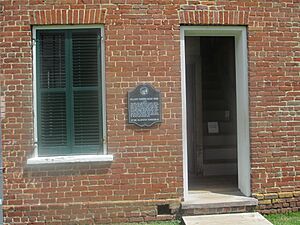
Bringing the Mansion Back to Life
In February 1972, Bellamy family members started Bellamy Mansion, Inc., hoping to begin fixing up and preserving the historic home. Sadly, just one month later, people set fire to the house. The fire department put out the flames, but a lot of the inside was badly damaged.
After the fire, Bellamy Mansion, Inc. faced many new challenges. The house had extensive damage to its plaster and much of the original wood was destroyed. Water used to put out the fire also caused damage. For the next two decades, more Bellamy family members and community volunteers worked to raise money and awareness for the restoration.
Throughout the 1970s and 1980s, the group worked on fixing the outside of the main house and the servants' quarters. They also raised money for the inside repairs. In 1989, the corporation gave the property to the Historic Preservation Foundation of North Carolina. This made the mansion a public historic site. Over the next few years, the necessary inside repairs were finished. In 1994, the Bellamy Mansion Museum of History and Design Arts officially opened its doors.
Today, the Bellamy Mansion is a working museum. It focuses on history and design arts and is cared for by Preservation North Carolina. The museum often has changing exhibits and hosts community events, like the annual garden tour for the famous North Carolina Azalea Festival. In 2001, the carriage house was rebuilt and became the museum's visitor center and office. The unique slave quarters, fully restored by 2014, show what life was like for enslaved workers. Because they were built just a few years before the abolition of slavery, they are some of the best-preserved examples of urban slave housing in the country.
The Bellamy Mansion is a nonprofit organization and has many volunteers from the Wilmington community. These volunteers know a lot about the Bellamy family and the mansion's history. Tours are given at the museum Tuesday through Saturday from 10:00 AM to 5:00 PM, and Sunday from 1:00 PM to 5:00 PM. The Bellamy Mansion is also available for weddings and special events. You can find it at 503 Market Street in Wilmington or visit its website at www.bellamymansion.org.
See also
 In Spanish: Bellamy Mansion para niños
In Spanish: Bellamy Mansion para niños


